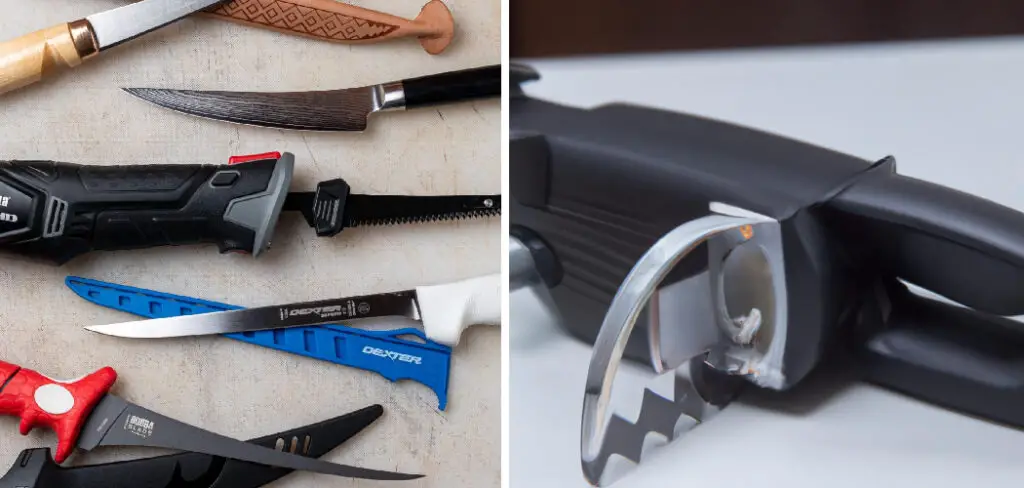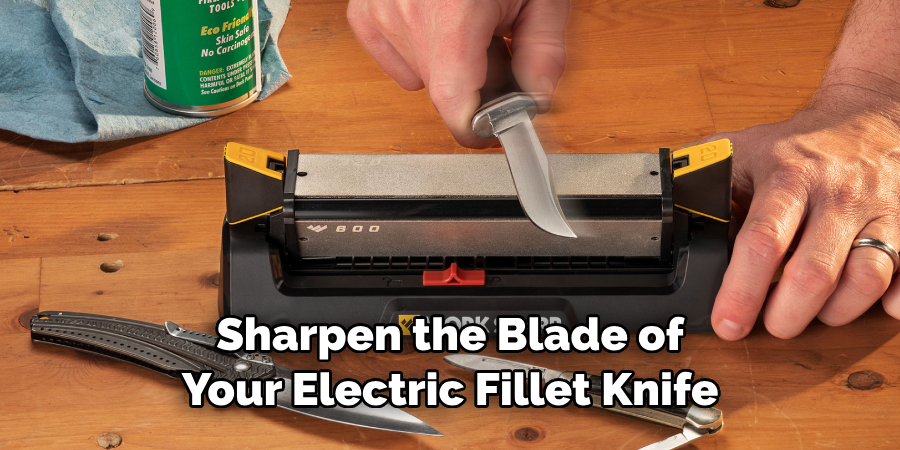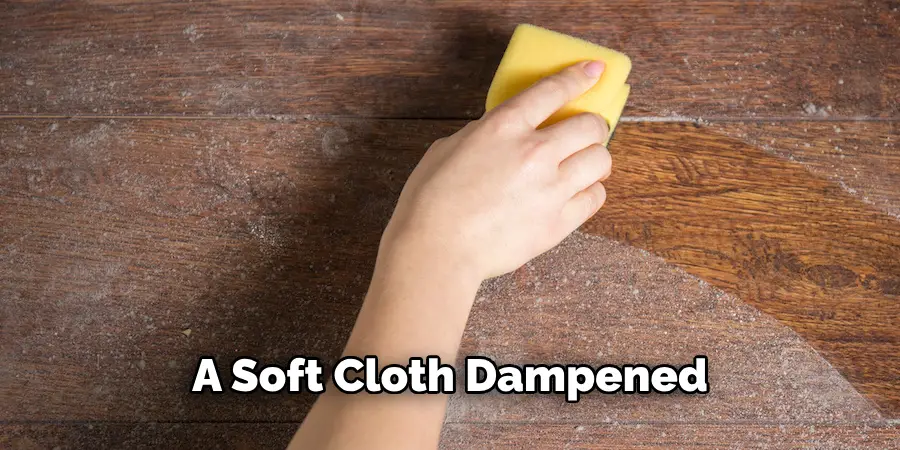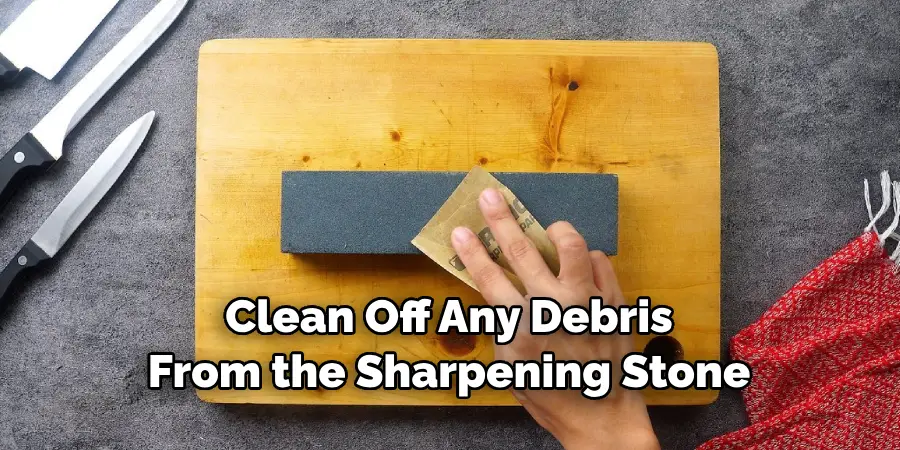Most of us have experienced the struggle of trying to fillet a fish with a dull electric knife blade. Sure, you can force it through the layers of tough scales and skin, but it takes more effort than necessary and leaves your hands feeling sore and exhausted. We all know how important having a sharp electric fillet knife is when fishing; it makes your job faster and easier, and you’ll also get much cleaner results with minimal strain.

In this blog post, we’ll give step-by-step instructions on how to sharpen electric fillet knife blades so that they stay sharp for longer – making you an overall more successful fisherman ready for the following catch!
Tools and Materials You Will Need to Sharpen Electric Fillet Knife Blades
- Electric knife sharpening stone
- Soft cloth
- Small container of water
- Light mineral oil (optional)
- Rubbing alcohol (optional)
Step by Step Guidelines on How to Sharpen Electric Fillet Knife Blades
Step 1: Begin by Unplugging the Electric Fillet Knife
Before you begin sharpening the blade of your electric fillet knife, make sure to unplug it and remove any batteries. This will ensure that you don’t accidentally turn on the power while sharpening and cut yourself or damage the blade. So, keep it unplugged and set aside until you’re finished sharpening.
Step 2: Soak the Electric Knife Sharpening Stone in Water
Next, fill your small container with water and submerge the electric knife sharpening stone for about 10 minutes. This will help to lubricate its surface when you begin to sharpen the blade of your electric fillet knife. Once the stone is fully saturated, remove it from the container and pat dry with a soft cloth.

Step 3: Position Your Electric Fillet Knife on the Sharpening Stone
Now it’s time to begin sharpening your electric fillet knife blade. To do this, place the cutting edge of the blade flat against the electric knife sharpening stone and hold the blade at an angle of about 20 degrees. You want to be sure that you are evenly distributing pressure while sharpening, so use both hands to steady the knife and stone as you move it in a back-and-forth motion.
Step 4: Sharpen Both Sides of the Blade
Once you’ve finished one side of the blade, flip it over and repeat the same process on the other side. Be sure to keep a consistent angle throughout the sharpening process in order to achieve even results. This step may take several minutes depending on the level of dullness of your electric fillet knife blade.
Step 5: Clean and Oil the Blade (Optional)
Once you’ve finished sharpening both sides of the blade, it’s time to clean and oil it. To do this, simply wipe off any residue from the blade with a soft cloth dampened in rubbing alcohol. Then, add a few drops of light mineral oil and rub the blade until it is completely covered. This will help to protect the metal from rusting and ensure that your electric fillet knife stays sharp for longer!

And there you have it – five simple steps on how to sharpen electric fillet knife blades! With this guide in hand, you’ll be sure to achieve clean, even results with minimal effort – giving you the upper hand in your next fishing trip! Good luck and happy fishing!
Additional Tips and Tricks to Sharpen Electric Fillet Knife Blades
- Clean the blade thoroughly with hot water and soap before sharpening it. This will help prevent debris from clogging up the sharpening stone or disk, leading to an uneven finish.
- Always keep a steady pressure on the blade when using the sharpener. Doing so can create a more even edge and make sure that each side of the blade is sharpened evenly.
- If the blade starts to feel dull after a few passes, it may be time to switch to a finer grit stone or disk. This will help refine the edge and bring it back to life!
- Be careful not to over-sharpen the blade. Doing so can create an edge that’s too thin and prone to chipping and breaking. A few passes should be enough to restore the blade’s sharpness.
- When finished, always make sure to clean off any debris from the sharpening stone or disk before storing it away. This will help keep your electric fillet knife blades looking and performing their best!
- Finally, remember to properly store your electric fillet knife blades after each use. Keeping them in a clean, dry place will extend their lifespan, and make sure they are ready for the next time you need to sharpen them.

Following these tips will help ensure that your electric fillet knife blades stay sharp and last as long as possible! With regular maintenance and care, you can enjoy their precision cutting power for years to come.
Precautions Need to Follow for Sharpening Electric Fillet Knife Blades
- Never attempt to sharpen electric fillet knife blades without the proper protective safety gear. It is important to wear gloves, safety goggles, and a face shield to protect yourself from any flying debris that may occur during the sharpening process.
- Secure the blade of your electric fillet knife in a vice or clamp before you begin sharpening it with a grinding wheel or fine-grit sandpaper. This will keep the blade in place and prevent it from moving while you are sharpening it.
- Use a light touch when sharpening your electric fillet knife. Do not press too hard against the grinding wheel or sandpaper, as this can cause damage to the blade and reduce its effectiveness. Work slowly and evenly across the blade and keep track of your progress so that you do not over-sharpen it.
- Apply only light pressure to the end of the blade when sharpening. Be careful not to put too much force on the tip, as this can cause damage and blunt the blade prematurely.
- After sharpening, remove any debris from the blade with a clean cloth and check that it is sharp. If not, repeat the sharpening process until the desired level of sharpness is achieved.
- After you are finished sharpening your electric fillet knife, always make sure that it is stored safely in its case or a sheath when not in use to prevent any accidents from occurring. Additionally, keep your sharpening materials stored away from children and pets to ensure their safety.
Finally, never forget to wash your hands thoroughly after handling an electric fillet knife or any sharpening tools before eating or drinking. This will help keep you safe and prevent accidental injury. With these precautions in mind, you can confidently sharpen your electric fillet knife blades!
Frequently Asked Questions
How Often Should I Sharpen My Electric Fillet Knife Blades?
It is recommended that you sharpen your electric fillet knife blades every two to three months, or whenever you notice that they are beginning to become dull. Doing so will help maintain the optimal performance of the blade and ensure it remains safe to use.
Is It Possible To Over-Sharpen Electric Fillet Knife Blades?
Yes, it is possible to over-sharpen electric fillet knife blades. If you notice that the blade has become excessively sharp or brittle, it may be a sign of over-sharpening. In this case, it’s best to stop sharpening and allow the blade to rest until it returns to its normal state.
What Is the Best Way To Sharpen Electric Fillet Knife Blades?
Using a sharpening stone is typically the best way to sharpen electric fillet knife blades. Sharpening stones come in a variety of grit sizes, so you can choose one that best suits your needs. Be sure to use light even strokes and remember to always work in the same direction along the length of the blade. This will help ensure a consistent sharpening job.
Do I Need To Clean My Electric Fillet Knife Blades Before Sharpening?
Yes, it’s important to make sure that your electric fillet knife blades are clean before sharpening. As you sharpen, particles from the stone may embed themselves in the blade, making it more susceptible to corrosion. To avoid this, make sure that you thoroughly clean the blades with warm water and mild detergent before sharpening. Once they are clean, dry them off completely with a soft cloth before beginning the sharpening process.

What Should I Avoid When Sharpening Electric Fillet Knife Blades?
When sharpening electric fillet knife blades, it’s important to avoid using too much pressure. This can cause excess wear or even damage the blade, so be sure to use light and even strokes when working with a sharpening stone.
Additionally, make sure you are only sharpening one side of the blade at a time and never sharpen in circles or back and forth. Lastly, be sure to use the correct grit size of stone for your blade’s material type. Using an excessively coarse grit or a stone that is too hard could damage your electric fillet knife blades.
Conclusion
All in all, knowing how to sharpen electric fillet knife blades properly is essential for having a safe and effective cutting experience. With the right knowledge and tools, you can easily keep your electric fillet knife blades sharp and perform at their best.
Be sure to always clean and dry off the blades before sharpening, use light even strokes when working with a sharpening stone, and take care not to over-sharpen or use an excessively coarse grit. Following these tips and guidelines will help you get the most out of your electric fillet knife blades. Happy sharpening!
Professional Focus
Angela Ervin, a former interior designer turned blogger, specializes in kitchen design and renovations. Through her website, she blends her passion for cooking with design expertise, sharing practical and creative ideas. Known for balancing functionality and beauty, Angela’s insightful content has made her a trusted voice in home design and lifestyle.
About the Author
Angela Ervin, an experienced interior designer and blogger, combines her passion for kitchen renovations with storytelling. Living in Petersburg with her family, she enjoys cooking and testing her projects firsthand. Known for her humor and relatable style, Angela shares creative, functional design insights through her content, making her a trusted voice in home design.
Education History
University: Virginia Commonwealth University
Degree: Bachelor of Fine Arts (BFA) in Interior Design
- Angela’s education at VCU focused on mastering core interior design principles, including spatial planning, color theory, materials selection, and sustainable design practices.
- She gained hands-on experience through studio projects and collaborative design exercises, which honed her ability to create functional and aesthetically pleasing environments.
- Her coursework also emphasized problem-solving and practical applications of design, preparing her for real-world projects like her self-directed kitchen renovations.
- The program’s strong foundation in both technical skills and creative expression shaped Angela’s ability to seamlessly integrate form and function in her work.


